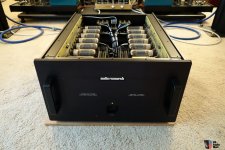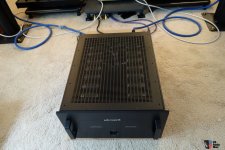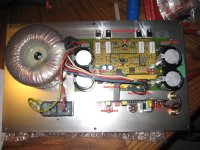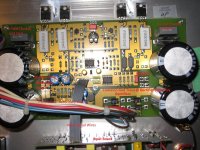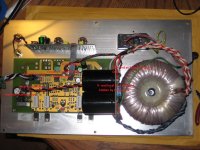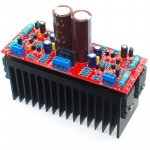Salvaging transformers in the DIY field often leads to using the wrong voltage resulting in having to resort to tricks. It is more efficient and elegant to design with the right values not to use what one has.
Agreed. But using a series resistor with a regulator isn't exactly a trick. I always use one, even when I have the "right" voltage. And they even show how to calculate the resistor value on the datasheets.
Buying everything new would be a deal breaker for me.
Last edited:
I have an Adcom GFA-535 and found that right channel ground wasn't wired like the left channel ground. I had intended to dig deeper into the reason because it bothered me a good deal, but someone here on the forum beat me to it and realized that Adcom had the ground return right next to where the transformer center tap is wired into the PSU board. Noise central! I need to fix that.
........You are probably right. Though lots of tube produces heat; a different angle picture shows just enough verticle space. An advertisement on net as follows............
Yes, it can be seen better in these photos. the tubes are very close to the upper ventilation grille, and the small fan will help keep heat from building up inside the compartment. Also, the fan seems to be self-adjusting in speed, which I find even more disconcerting by the excessive noise in this unit. I bend over again that the dust played havoc with the fan. It is an amplifier for audiophile use, not for PA ..... If the fan speed is automatic, the original fan can be replaced by a Noctua model without regulator included, as it is provided by the unit. (Noctua NF-A8 FLX) And it's cheaper too.
Thanks for the link, greetings
Attachments
Agreed. But using a series resistor with a regulator isn't exactly a trick. I always use one, even when I have the "right" voltage. And they even show how to calculate the resistor value on the datasheets.
Buying everything new would be a deal breaker for me.
I agree with that, a trained repairer should know how to calculate the resistance value using Ohm's Law. Super simple nowadays with online calculators, if you've already forgotten. It is not always about getting the original spare part and changing it, in the world of electronics components must constantly be adapted, it should not be confused with "tricks", simply knowing what you are doing.
I haven't forgotten.if you've already forgotten.
in the world of electronics components must constantly be adapted, it should not be confused with "tricks", simply knowing what you are doing.
In my present build, I had a choice between dissipating (wasting) 7 watts between 6 three watt resistors (which I buy in bulk), or adding a second transformer to the mix (a transformer I would have to buy). That's a no brainer.
PWM has pros and cons. One of the cons is that it can lead to clicking noises at low RPMs. According to Silent PC Review (SPCR), fans of the same make tend to be a little bit quieter when designed for single-RPM use (versus PWM). I don't know, though, if that site's testing is comprehensive enough to prove that rule.Yes, it can be seen better in these photos. the tubes are very close to the upper ventilation grille, and the small fan will help keep heat from building up inside the compartment. Also, the fan seems to be self-adjusting in speed, which I find even more disconcerting by the excessive noise in this unit. I bend over again that the dust played havoc with the fan. It is an amplifier for audiophile use, not for PA ..... If the fan speed is automatic, the original fan can be replaced by a Noctua model without regulator included, as it is provided by the unit. (Noctua NF-A8 FLX) And it's cheaper too.
Thanks for the link, greetings
One of the cons of PWM is that it can be a trick to make people think the design is adequate (in terms of being quiet enough). But, in situations when more power is called for, suddenly the noise level is no longer acceptable. It's a bit like bait and switch.
Another con, according to some, is that variable fan speed noise is more distracting than a constant noise level.
The way I see it, if one is going to use a fan in such a tube-plentiful high-power design, it should be really large (in order to make it possible to cool a large area with a single fan at low RPM) and operate at a single speed. The cooling provided by the fan should be overbuilt to some degree in order to compensate for dust buildup. One possible drawback of a large fan, though, is a dead zone in the center. So, the design has to keep the tubes positioned to receive the airflow the fan is capable of producing. A 140mm fan and low RPM may be all that's necessary to cool a lot of hot-running tube amps (pure speculation). But, considering the high cost of elaborate tube amps I would be inclined toward the 200mm Noctua, as long as it can operate at very low speeds "inaudibly" (quiet enough to be acceptable to the customer's actual hearing in a very quiet environment).
One thing that could also improve the design is to do what a lot of PC power supplies are doing these days (and some PA amps) which is to make it semi-passive, where the fan doesn't turn on until a certain level of load and/or heat appears. A drawback to that approach is that designers tend to push things in terms of promoting low noise over component reliability. For instance, Corsair released an RM series of PC power supplies that were semi-passive. Critics argued that the level of heat the company decided to allow before fans turned on was too high for good longevity. It can be a way to skimp on other aspects of design quality, like heatsink efficiency/ability. Like PWM, it can be seen as a bit like bait and switch if it's not implemented really well.
The semi-passive design could be used simply as a failsafe against user error, also — like trying to operate one of these amps in a very hot environment. The fan, in this design scenario, would only activate when the amp is pushed outside of the defined acceptable parameters, the parameters given to the buyer in the specs.
Also, if a fan is used for general cooling, not just as an emergency system, the amp should tell the user when the fan isn't performing adequately. There should be a sensor to monitor the heat level. Fans are mechanical devices (moving parts) and thus should be considered failure-prone. Of course, tubes are their own animal in that regard!
The last thing I'd like to say is that amps with tiny fans that have three speed selection switches are a stupid design for home use. Firstly, unless the switch is on the outside of the case or on a remote it's inconvenient. Secondly, the user isn't going to know which fan speed is acceptable unless there is a temperature gauge in the unit. Thirdly, if the low setting is adequate then why put in the other two speeds? While there are legitimate answers to that question, I feel it's too much complexity and speaks to a sloppy design. It's not good to have customers guess about how much cooling is needed. Or worse — to sacrifice tube lifespan to compensate for a fan that's too noisy.
Nowadays fans can be purchased with a PWM input, so you dont have to drive the motor with one yourself. Some designs simply convert to a voltage internally and use that to control the motor driver chip RPM target. (I learned this while studying the difference PWM frequency made and found some fans would respond as well to DC applied to the "PWM input")
I have a pair of German hornspeakers with powered woofers from the late 1990s. They were amplified by my diy 26 preamp and 45 SET amps for many years. There was some hum and hiss, but I attributed that to my diy tube electronics, especially the 26 preamp.
About three years ago I built the diyAudio Sony VFET amplifier and then the Luminaria (VFET) preamplifier, and then more VFET/SIT amplifiers. One of the noticeable improvements in my system was the much lower noise level. However, after a period of aclimatization to the much lower noise level, I noticed that there was still some noise, mostly from the powered woofers.
Since the speakers were nearly 20 years old and long out of warranty, I opened them up and noticed that one of the electrolytic capacitors in the woofer amplifier power supply was leaky. So I replaced all of the power supply capacitors but the noise level was not that much different. I then looked at the woofer amplifier layout critically, based on what I had learned along the way as an diyer with no formal electronics education, and I was not happy with what I saw, so I made some changes. It's quiet now.
Before and after pictures:
About three years ago I built the diyAudio Sony VFET amplifier and then the Luminaria (VFET) preamplifier, and then more VFET/SIT amplifiers. One of the noticeable improvements in my system was the much lower noise level. However, after a period of aclimatization to the much lower noise level, I noticed that there was still some noise, mostly from the powered woofers.
Since the speakers were nearly 20 years old and long out of warranty, I opened them up and noticed that one of the electrolytic capacitors in the woofer amplifier power supply was leaky. So I replaced all of the power supply capacitors but the noise level was not that much different. I then looked at the woofer amplifier layout critically, based on what I had learned along the way as an diyer with no formal electronics education, and I was not happy with what I saw, so I made some changes. It's quiet now.
Before and after pictures:
Attachments
One recently popped into my head.
That miserable foam surround on speakers - you know, that stuff which deteriorates over time. Coundnt just have used butyl rubber, could ya? Oh, it makes such a big difference I'm sure - whether its in the sound or more likely, on the spreadsheet.
I wonder what the cubic foot volume of speakers / cabinets in landfills world-wide is, simply due to that one design decision alone?
From Ohm Walshes to Bostons, to cheap RCA branded boxes with Linaeum tweeters; I wouldnt mind giving any designer that chose that particular stuff a swift kick in the butt - /r/*******design
The LS3/5As I once found used butyl rubber. Still working fine after 35 years probably.
That miserable foam surround on speakers - you know, that stuff which deteriorates over time. Coundnt just have used butyl rubber, could ya? Oh, it makes such a big difference I'm sure - whether its in the sound or more likely, on the spreadsheet.
I wonder what the cubic foot volume of speakers / cabinets in landfills world-wide is, simply due to that one design decision alone?
From Ohm Walshes to Bostons, to cheap RCA branded boxes with Linaeum tweeters; I wouldnt mind giving any designer that chose that particular stuff a swift kick in the butt - /r/*******design
The LS3/5As I once found used butyl rubber. Still working fine after 35 years probably.
Funny how KEF where one of the big offenders, they used Butyl in the beginning, and are using it today, but in the middle there, 90s, they used foam and it sucked.
I had some Mission 770's and they were unable to glue the butyl to the poly(prop, Amyde, whatever it was) which was a different but similarly annoying issue.
I really wanted a pair of Kef 104/2, but all the internal "isobaric" drivers have long since rotted and can not be saved.
I had some Mission 770's and they were unable to glue the butyl to the poly(prop, Amyde, whatever it was) which was a different but similarly annoying issue.
I really wanted a pair of Kef 104/2, but all the internal "isobaric" drivers have long since rotted and can not be saved.
Seconded, foam is lucky to last a year or two in the tropics.One recently popped into my head.
That miserable foam surround on speakers - you know, that stuff which deteriorates over time. Coundnt just have used butyl rubber, could ya? Oh, it makes such a big difference I'm sure - whether its in the sound or more likely, on the spreadsheet....
probably.
Self destructing foam is also found in some headphone cushions
Poor DIY kit engineering.
UNISIAN Class AB 2.0 Channels Audio amplifier board High power 2X80W TTA1943 TTC5200 class AB Hifi stereo audio amplifiers|Amplifier| - AliExpress
UNISIAN Class AB 2.0 Channels Audio amplifier board High power 2X80W TTA1943 TTC5200 class AB Hifi stereo audio amplifiers|Amplifier| - AliExpress
Attachments
The power transistors do not make very good use of the heatsink.
Ahh yes, agree.
Jan
- Status
- This old topic is closed. If you want to reopen this topic, contact a moderator using the "Report Post" button.
- Home
- Member Areas
- The Lounge
- Biggest engineering mistakes in audiophile gear
